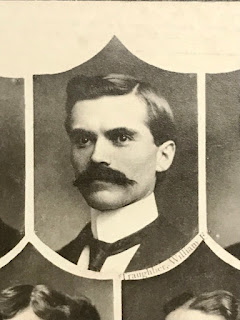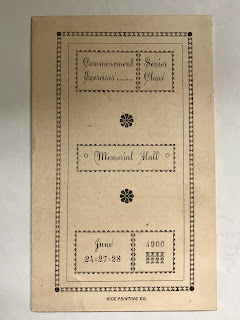Chasing History: Exploring My Ancestral Roots - Post #3
by Tonya Graham McQuade
William Francis “Frank” Traughber, my great grandfather, graduated from ATSU’s College of Osteopathy in June 1900. This much I knew. It turns out, as I fortunately discovered through Ancestry.com prior to our visit, quite a few family members also graduated from this same school – the first of its kind, with a very forward-thinking approach to medicine – including the husbands of two of my great grandmother Nora Petree’s sisters: Delos Austin Bragg (Lettie’s husband) and Victor C. Hoefner (Jessie’s husband).
None of us had ever been quite sure what it meant to be a Doctor of Osteopathy (DO). We knew that Dr. Traughber worked for a time as an Osteopath in Mexico, Missouri, near his hometown of Centralia – and that his and Nora’s first son, Frank, was born there. We also knew he had later graduated from the College of Physicians and Surgeons at the University of Southern California (USC) in June 1911 and become a physician and surgeon in Los Angeles – but he also continued to advertise himself as an osteopathic doctor, so his early teachings continued to have an impact on his philosophy of medicine and health.
According to the school’s website, “Andrew Taylor Still, DO, the founder of osteopathic medicine and ATSU, was a licensed physician and surgeon, healthcare innovator, abolitionist, civil war hospital steward, and suffragist who created opportunities for women in medicine as early as the 1890s. Today, ATSU supports students who learn and serve in diverse, underserved, urban, and rural communities across America. ATSU’s alumni also practice, work, and volunteer across the world. Many hold leadership positions dedicated to bringing quality healthcare to those in greatest need.” He sounds like a man who was a progressive leader, an innovative thinker, a seeker after justice, a doctor with a truly healing touch, and a compassionate individual with desire to “do good” in the world!
The museum now houses the original building for the School of Osteopathy, as well as one of the original buildings from the farm where A.T. Still was born:
checking out the original school building
Statue of Dr. Andrew Taylor Still, founder of Osteopathy and ATSU
According to another explanation we read, “Andrew Taylor Still’s osteopathy was a drug-free, patient-focused manipulative treatment founded on the belief that the best way for the body to heal is by working with the natural healing powers within the body. The body is able to heal itself if given the right conditions and it can be assisted back to health if the osteopath knew how to manipulate the body and saw the problem and patient holistically. Manipulative medicine gave patients an alternative to traditional medical practices of blistering, bleeding, and medicating away illnesses.”
When you consider that this was a time when “blistering, bleeding, and medicating” were still commonly used, and that many “quacks” still roamed the country selling their miracle cures, this was a rather revolutionary approach to healthcare. Soon, other colleges of osteopathy began springing up in other cities and states. Today, according to one website, “There are currently 38 accredited colleges of osteopathic medicine in the United States. These colleges are accredited to deliver instruction at 59 teaching locations in 34 states. In the current academic year, these colleges are educating more than 34,000 future physicians—25 percent of all U.S. medical students."
Prior to our tour, we explored the museum’s entry exhibits, where it discussed the role women played from the earliest years of osteopathy. I liked that Dr. Still believed strongly that women, too, could be excellent doctors. While most medical doors were closed to them – and those that were open often did not allow them full access to the curriculum – osteopathy granted women full admission. I learned that one of Nora’s nieces, Martha Petree, was among ASTU’s early graduates.
What is Osteopathic Manipulative Treatment?
The goal of osteopathic manipulative treatment (OMT) is to remove obstructions within the body. This allows the body to heal itself by restoring structural integrity. OMT involves moving the patient’s muscles and joints with techniques like stretching, applying pressure, and resistance of motion. It is applied to the entire musculoskeletal system, nervous system, and lymphatic system. Each technique is adjusted to best suit the doctor and the patient’s body.
Alternative to Drugs
Drugs were strongly discouraged in the earliest days of osteopathy due to inconsistent and often negative results, Consequently, osteopaths were expected to palpate and detect abnormalities in the body beneath various tissues and muscles and set the body back into place through osteopathic manipulative treatment.
Holistic Health
Osteopathic manipulative medicine incorporates a holistic healthcare approach. It acknowledges the mind, body, and spirit when making a diagnosis and determining treatments. A patient’s medical history, lifestyle, emotional and mental health are all considered before giving treatments. Treatments can often include adjustments, patient specific exercises, and osteopathic manipulative treatments.
Our guide Elaine, as well as another museum coordinator whose name I no longer recall, led us around the museum, explaining more about A.T. Still and the field of Osteopathy, showing us some of his tools and equipment, describing his teaching and healing methods, and answering our questions. A few of the displays that stood out were the photos of dissections (which they did outdoors to raise awareness and prevent rumors from spreading), the “nerve” skeleton, the old X-Ray machine, the early manipulation tables, and the family photos and personal items housed in the museum.
This transcript shows that W.F. Traughber graduated from Centralia High School in 1894, then from Quincy Business College in Quincy, Illinois in 1895. He worked for a while as a farmer and miller before beginning his studies at ATSU at age 24. After graduating, he returned to Centralia – then later, Mexico, Missouri - to practice osteopathy.
I found it interesting to see some of the people of the time who were supporters of A.T. Still and his approaching to healthcare:
Stay tuned for my next blog post: Exploring Kirksville's Courthouse & Museum

























_crop.jpg)
Very interesting!
ReplyDeleteThanks, Janice! So glad we were able to connect!
Delete